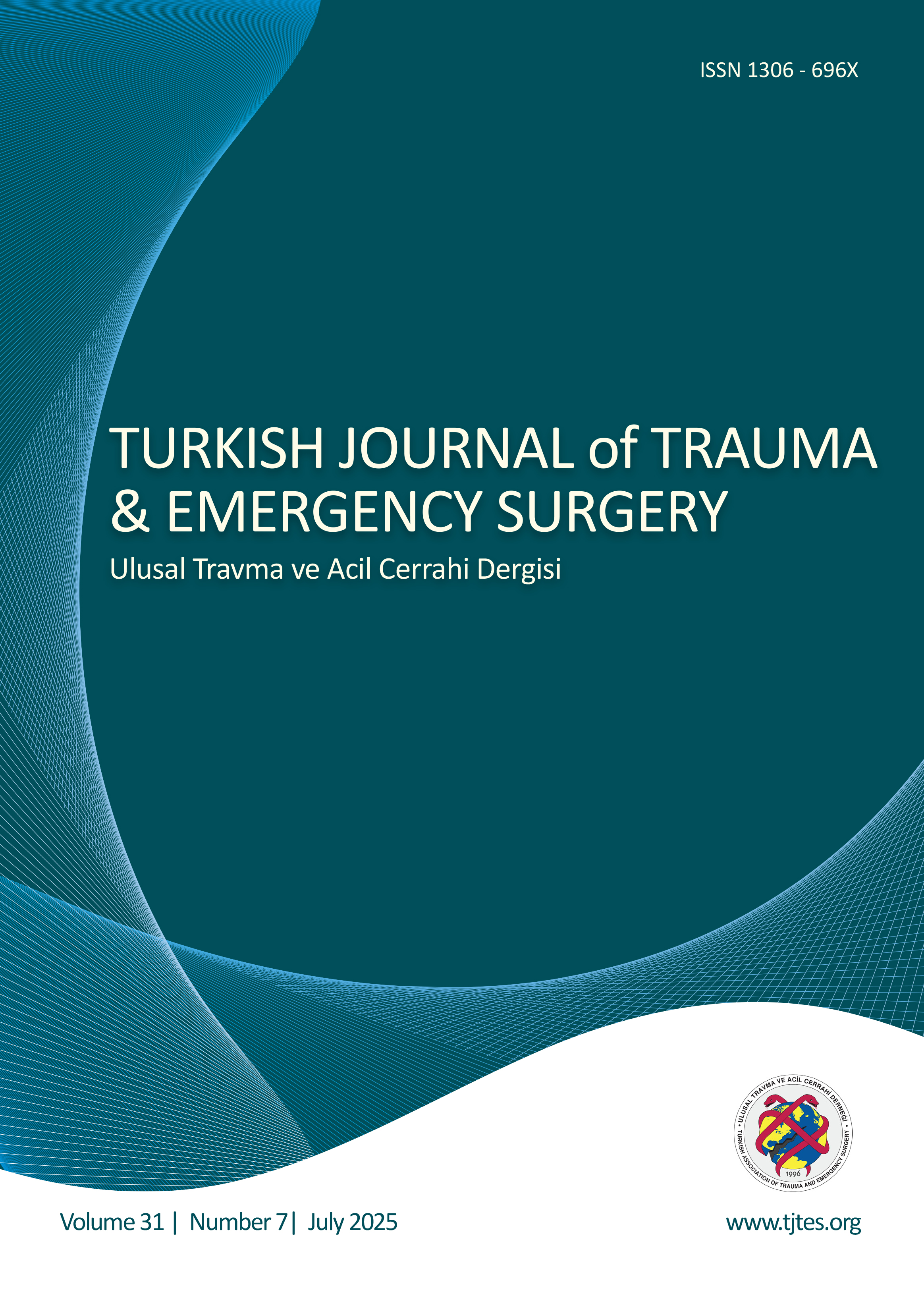Hızlı Arama
Farklı çap ve tipteki mermi çekirdeklerinin ekstremiteler üzerindeki deneysel yaralanma modelleri
Ilknur Arslan1, Gökhan İbrahim Öğünç2, Özhan Pazarcı3, Ahmet Hilal4, Mehmet Eryılmaz51Adana Şehi̇r Eği̇ti̇m ve Araştırma Hastanesi̇, Çocuk Yoğun Bakım, Adana, Türkiye2Jandarma ve Sahil Güvenlik Akademisi, Adli Bilimler Enstitüsü, Kriminalistik Anabilim Dalı Başkanlığı, Ankara, Türkiye
3Sağlık Bilimleri Üniversitesi, Adana Şehir Eğitim ve Araştırma Hastanesi, Ortopedi ve Travmatoloji Kliniği, Adana, Türkiye
4Çukurova Üniversitesi, Adli Bilimler Bölüm Başkanlığı, Adana, Türkiye
5Sağlık Bilimleri Üniversitesi, Gülhane Eğitim Ve Araştırma Hastanesi, Genel Cerrahi, Ankara, Türkiye
AMAÇ: Yaşamı tehdit eden yaralanmaların ikinci önde gelen nedeni olan ve son 50 yılda savaşla ilgili vakaların %63'ünü oluşturan ateşli silah yaralanmaları ağırlıklı ekstremitelerde meydana gelir. Ekstremite yaralanmaları daha düşük ölüm oranlarına sahip olsa da, komplikasyonları azaltmak için hala acil tedavi gerektirmektedir. Balistik mum ve jelatin gibi doku vekillerinin kullanıldığı yara balistiği çalışmaları, canlı dokulardan farklılıkları nedeniyle sınırlılıklara sahiptir ve bu testlerle elde edilecek veriler gerçekte mermi çekirdeğinin farklı direnç ve esnekliğe sahip kemik ve kastan oluşan ekstremiteler üzerindeki etkisi hakkında yeterli veri sağlamamaktadır. Bu çalışmanın amacı, yaygın olarak kullanılan mühimmatın canlı dokularda neden olduğu hasarı analiz etmek ve sağlık çalışanlarına acil bakımı iyileştirmek için kritik bilgiler sağlamaktır.
GEREÇ VE YÖNTEM: Bu çalışmada, daha önce başka bir çalışmada kullanılmış ve yaşamsal belirti göstermeyen 3-4 yaşlarında 6 Adana ırkı koyun kullanıldı. Yerel etik kurulundan etik onay alınmıştır. Deneme atışları 9×19 mm (M822), 5.56×45 mm (SS109) ve 7.62×51 mm (M80) mermiler kullanılarak 300 cm mesafeden, yan pozisyondaki koyunların ön bacakları hedef alınarak yapıldı. Atışların ardından, giriş ve çıkış yaraları fotoğraflanmış ve analiz için ekstremitelerin ön-arka ve yan röntgen görüntüleri çekilmiştir. Deney, farklı mühimmat türlerinin ekstremiteler üzerindeki etkilerini incelemeyi ve ateşli silah yarası özellikleri hakkında bilgi edinmeyi amaçlamıştır.
BULGULAR: İlk test grubunda (denek A ve B), röntgenler eklem bütünlüğü kaybı, çok parçalı kırıklar ve yumuşak dokuda kavitasyon gösterdi, kemik parçaları çıkış hattı boyunca dağıldı, ancak boşlukta mermi parçası yoktu. M822 mermisi tipik bir giriş yarası ve daha küçük bir çıkış yarası oluşturmuştur. İkinci grupta (C ve D denekleri), SS109 mermileri kemik, kas, tendon ve deri parçalanmasına neden olmuş ve mermi parçaları şarapnel etkisi yaratmıştır. Çıkış yaraları daha genişti ve düzensiz kenarlara sahipti. Üçüncü grupta (E ve F denekleri), M80 mermileri yüksek kinetik enerji nedeniyle geniş doku parçalanmasına neden olmuş ve geniş, düzensiz çıkış yaraları oluşturmuştur.
SONUÇ: Bu çalışma, M80 mermilerinin daha yüksek kinetik enerji yoğunluğu ve yapısı nedeniyle M822 ve SS109 mermilerine göre daha ciddi kemik ve yumuşak doku hasarına neden olduğunu ortaya koymuştur. Doku vekillerinin kullanıldığı önceki araştırmalardan farklı olarak bu deney, mühimmatın gerçek dokular üzerindeki etkilerini göstermiştir. Radyoloji, adli tıp ve sağlık uzmanları, ateşli silah yaralanmalarının mühimmat özelliklerine göre değiştiğini bilmeli ve hasta sonuçlarını iyileştirmek için bu anlayışla en uygun müdahale ve tedavi tekniklerini uygulamalıdır.
Experimental wounding models of different bullet types and diameters on extremities
Ilknur Arslan1, Gökhan İbrahim Öğünç2, Özhan Pazarcı3, Ahmet Hilal4, Mehmet Eryılmaz51Adana City Training and Research Hospital, Pediatric Intensive Care Unit, Adana-Türkiye2Department of Criminalistics, Gendarmerie and Coast Guard Academy, Institute of Forensic Sciences, Ankara-Türkiye
3Health Science University, Adana City Training and Research Hospital, Orthopedics and Traumatology Clinic, Adana-Türkiye
4Department of Forensic Sciences, Çukurova University, Adana-Türkiye
5Department of General Surgery, Health Sciences University, Gulhane Training And Research Hospital, Ankara-Türkiye
BACKGROUND: Gunshot wounds are the second leading cause of life-threatening injuries and frequently affect the extremities, accounting for 63% of combat-related cases over the past 50 years. Although extremity injuries have lower mortality rates, they still require urgent treatment to reduce complications. Wound ballistics studies often use tissue surrogates like ballistic wax and gelatin, which have limitations due to their dissimilarity to living tissues. There is insufficient data on the effects of gunshots on extremities composed of bone and muscle, which differ in resistance and elasticity. This study aims to analyze the damage caused by commonly used ammunition in living tissue and provide healthcare professionals with critical insights to improve emergency care.
METHODS: The study involved six Adana-breed sheep, aged 3-4 years, previously used in another study and showing no vital signs. Ethical approval was obtained from the local ethics committee. Test shots were conducted using 9×19 mm (M822), 5.56×45 mm (SS109), and 7.62×51 mm (M80) bullets from a distance of 300 cm, targeting the front legs of sheep positioned laterally. Following the shots, entry and exit wounds were photographed, and anteroposterior and lateral X-ray images of the extremities were taken for analysis. The aim was to examine the effects of different types of ammunition on extremities and provide insights into the characteristics of gunshot wounds.
RESULTS: In the first test group (subjects A and B), X-ray imaging revealed joint integrity loss, multi-part fractures, and cavitation in the soft tissue, with bone fragments distributed along the exit trajectory. No bullet fragments were found within the wound cavity. The M822 bullet produced a typical entry wound and a smaller, more defined exit wound. In the second group (subjects C and D), SS109 bullets caused fragmentation of bone, muscle, tendon, and skin. Bullet fragments created a shrapnel-like effect. The exit wounds were larger and had irregular edges. In the third group (subjects E and F), M80 bullets caused extensive tissue disruption due to their high kinetic energy. The resulting exit wounds were wide and irregular.
CONCLUSION: This study found that M80 bullets caused the most severe bone and soft tissue damage compared to M822 and SS109 bullets, primarily due to their higher kinetic energy density and structural characteristics. Unlike prior research using synthetic tissue models, this study demonstrates the real-tissue effects of different ammunition types. Radiologists, forensic medicine experts, and other healthcare professionals should be aware that firearm injuries vary depending on the bullets characteristics. Applying this understanding can lead to appropriate diagnoses and improved treatment strategies, ultimately enhancing patient outcomes.
Makale Dili: İngilizce




